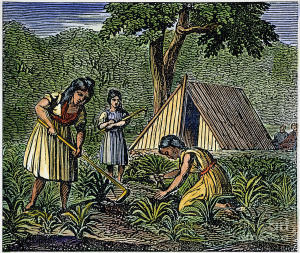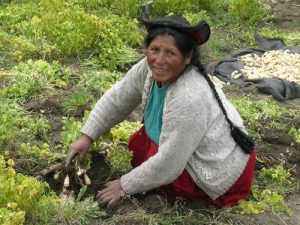 If you’re looking for the latest on progressive agricultural practices, you might want to look to the past. Specifically, to Native Americans. Long before the first New Jersey Grown logo appeared on a supermarket shelf, Natives were growing organically. Before Permaculture, Sustainability, and Localization became the cherished catchwords of hipsters and hippies, Natives were busy inventing them. Indeed, Native Americans were Going Green before Europeans created the need to Go Green.
If you’re looking for the latest on progressive agricultural practices, you might want to look to the past. Specifically, to Native Americans. Long before the first New Jersey Grown logo appeared on a supermarket shelf, Natives were growing organically. Before Permaculture, Sustainability, and Localization became the cherished catchwords of hipsters and hippies, Natives were busy inventing them. Indeed, Native Americans were Going Green before Europeans created the need to Go Green.
Native Americans began farming in what is now present-day Illinois around 7,000 years ago. Corn, or maize, was one of their most important crops. Native women, who generally oversaw land-ownership and -cultivation, were responsible for selecting seeds for desirable traits, maintaining species purity by planting different seeds sufficiently far apart to prevent cross-pollination. Were it not for this assiduous effort, corn may well have remained but a weed.
Along with corn, beans and squash were often planted in a pattern the Iroquois called the ‘Three Sisters’. In this technique, corn stalks serve as a natural pole for beans to climb, the vines acting to stabilize the corn plants against gusty summer thunderstorms. Squash vines, which grow horizontally, act as a living mulch, preventing water-evaporation and weed build-up. By fixing nitrogen in the soil, beans provide an immeasurable benefit to the following year’s crop.
More Native American farming facts:
- Natives could support roughly three times as many people per acre than ‘modern’ European farmers.
- To discourage the transit of pests from one plant to another, Natives ‘segregated’ like vegetable species.
- Because Natives did not use plows, their soils were healthier, more biologically diverse. (Plowing causes soil degradation).
- Corn-farming Indians in the New York State region were more productive than their European wheat-farming counterparts.
- Natives in the British Columbia regions practiced a sophisticated permaculture, using over 250 species of plants for food, tea, fuel, construction, fiber, canoes, dye and glue.
Some Native American farming practices, however, would be considered controversial by today’s standards. For instance, the Creek Indians, who occupied what is now present-day New York, were known to fertilize crops with diluted urine. Believe it or not, urine contains a host of minerals essential to plant-growth. A recent experiment using urine fertilizer produced 6’ tall tomato plants, 4’ collards and broccoli, and pumpkin and squash-vines that grew at a rate of 12 to 14 inches a day!
 Modern agriculture has been a boon in many ways, but has also scarred the environment, depleted nonrenewable resources, and spawned new and debilitating diseases. The time has come to look to the past, to the gentle and intuitive farming methods of the Native Americans, to a way of living that sustained and nourished us for over seven millennia.
Modern agriculture has been a boon in many ways, but has also scarred the environment, depleted nonrenewable resources, and spawned new and debilitating diseases. The time has come to look to the past, to the gentle and intuitive farming methods of the Native Americans, to a way of living that sustained and nourished us for over seven millennia.
